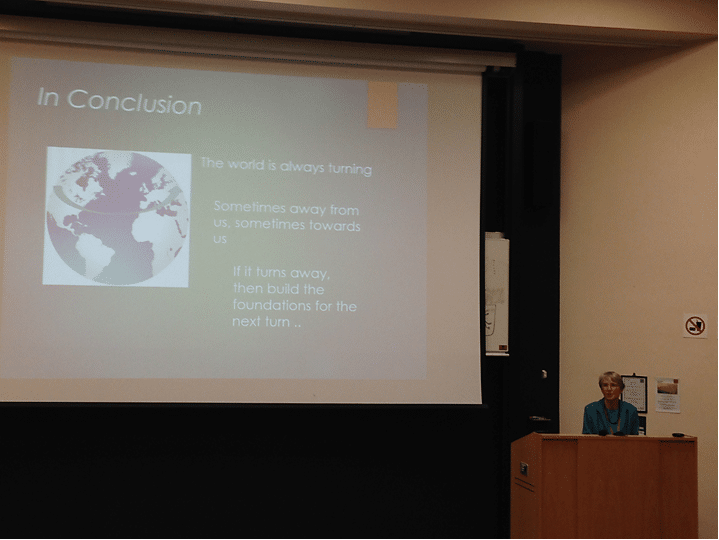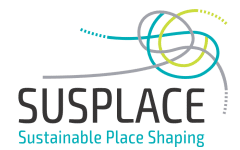
By Lorena Axinte and Cátia Rebelo
The UK-Ireland Planning Research Conference is an annual event which this year was hosted by Cardiff University’s School of Geography and Planning. The event celebrated the school’s 50 years of existence, bringing together academics and practitioners interested in sharing knowledge on spatial, regional, neighbourhood and community planning.
The theme of the conference was inspired by the progressive Wellbeing of Future Generations Act, a Welsh legislative document which compels public bodies to consider long-term development and strive to improve the social, economic, environmental and cultural well-being of Wales.
Gathering over 100 delegates, the conference was comprised of four plenaries, different parallel sessions and roundtables on tracks such as environment, climate change and natural resources; community well-being; governing places; infrastructure decision making; transport and mobility; planning theories and concepts; as well as educating planners and communities. Although the parallel sessions limited the number of presentations we were able to attend, the plenary sessions (led by speakers such as renowned professors Patsy Healey, Kevin Morgan and Mark Tewdwr-Jones, as well as Matthew Quinn – partner in SUSPLACE and representing the Welsh Government) certainly provided food for thought. Although difficult to decide on the most inspiring talk, we have to admit that getting the chance to listen to Patsy Healey was truly inspiring. Her presentation was definitely in line with our network’s underlying beliefs, emphasising the importance of promoting well-being through caring for place (conceived as socially produced from a relational assemblage) and by focusing on the co-production of daily life experiences (albeit ordinary ones).
Guided by our supervisors, Abid Mehmood and Terry Marsden, the three of us (Cátia, Lorena and Malin) ran a roundtable called ‘Regeneration, Learning, Experiencing – Three perspectives on the transformative capacity of sustainable place-shaping.’ Chaired by Abid Mehmood, the session began with Terry’s introduction of SUSPLACE, followed by individual 15-minute presentations of our projects and a final discussion.
The session attracted a good amount of participants (surprisingly for us, considering the numerous parallel session, but maybe the name Terry Marsden lured them) that came up with very useful comments and contributions to our work. In addition to the debates, this roundtable was very useful to train and develop our communication and presentation skills. We had already presented our projects before (and some papers) but it is always an exciting and sometimes distressing experience. The brief time allocated determined us to be concise, in spite of the many things we would have liked to share. Furthermore, this experience served to gain new and important contacts and spread the word about what we have done so far. In the end, we really enjoyed it and see it as a good preparation for the coming presentations.
The second day started with an early course entitled “How to get published” dedicated to early stage researchers and PhD students. The hour long session was ran by Francesca Sartorio, editor of the International Planning Studies – a journal from Taylor & Francis group. Francesca Sartorio explained to the participants the key points she looks at when assessing articles as well as useful tips to succeed in this important task of academia.
In a very relaxed and informal way Francesca Sartorio stressed the importance of getting published to be successful and progress in an academic career. She presented the United States system where to be constantly published in good quality journals is the way of getting jobs and negotiate the terms and conditions. Even though she does not entirely support this system, Francesca said that UK universities are adopting it more and more. Therefore, she shared some really interesting tips to increase our chances of being published while also explaining the publishing process.
Key points from an editor on how to get published:
- Follow the guidelines of the Journal that you are aiming for. It seems obvious but many people submit papers without reading the journal guidelines resulting in an automatic exclusion!
- Write a cover letter: this document is very important for the Editor as it help her to understand the researcher background and then decide which reviewers are best suited for the paper.
- Be patient: your paper will take at minimum three months to be published and for that everything needs to work perfectly which in reality never happens! The reviewers are doing voluntary work and there is a shortage of available ones right now. Besides, the process itself is quite lengthy since it goes through the editor to the selected reviewers (who have about two weeks to accept the paper or not – in which case a new reviewer must be sought) and then back to you.
- Last but not least, always answer the reviewers’ comments: when you get back your paper you can be rejected or accepted with minor or major revisions. If your paper is accepted be sure that you do a table or document that shows all the reviewers’ comments and your answers and alterations accordingly. This will really help the Editor to see if you have done the needed alterations or not and will fasten the process, since she only will get back to the reviewers if she is not sure about the alterations (reviewers are rare and valuable assets).
Finally, our experience was rounded off by the opportunity Abid provided us with: chairing a couple of parallel sessions on the Governing Places track. Although this role requires fairly simple tasks, we definitely worked out our organisational and time-management skills, while also practicing public speaking in front of an unknown audience. All in all, despite being long and intense, the two conference days have been a really rewarding experience which helped us make further steps in our (early) researcher careers, and spread the word about the work done at SUSPLACE.
